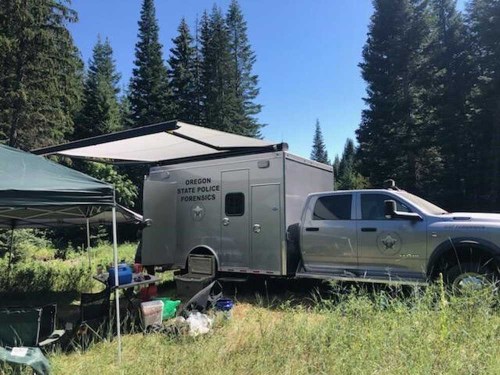Police find no bones at Finley Creek Jane Doe site
Published 11:00 am Wednesday, August 31, 2022

- An Oregon State Police forensic vehicle at the Finley Creek site 18 miles north of La Grande earlier this month.
ELGIN — The Finley Creek Jane Doe case, which has taken many twists and turns during the past four decades, took a pivot in the wrong direction. But investigators, including Oregon State Police, are refusing to give up.
Oregon State Police recently led an excavation project at a site near Finley Creek, 18 miles north of La Grande, where the remains of an unidentified woman were found in August 1978.
Trending
The work was conducted Aug. 16-17 by the OSP Forensics Service Division, the State Medical Examiner’s Office forensic anthropologist, OSP’s major crimes detectives and members of the Union County Search and Rescue team. The excavation was in response to recent work of the Finley Creek Jane Doe Task Force, which is investigating the unidentified remains of the woman found in 1978. The task force brought cadaver dogs to the site, and the dogs showed interest.
Union County Search and Rescue conducted a grid search of approximately 3 acres around the original burial site and the recent locations where the dogs showed interest. The team found more than 50 bones. The State Medical Examiner’s forensic anthropologist examined each bone, but none were of human origin, OSP reported in a press release.
Forensic scientists and detectives conducted excavations at the two points of interest from the cadaver dogs. They also excavated the original burial site. The three locations were examined by sifting dirt and material through screens in an attempt to locate even the smallest of bone fragments or other evidence that could be of use in determining an identity through DNA testing.
“Unfortunately, nothing of evidentiary value was discovered during the operation,” the press release stated.
State police said the agency and other law enforcement partners will continue to stay in contact with all interested parties in hopes of successfully resolving the identity of the Finley Creek Jane Doe and bringing closure to her family.
Melinda Jederberg, of La Grande, founded the Finely Creek Jane Doe Task Force in 2019. She said she appreciates the hard work OSP did at the site and said it has helped the investigation move forward.
Trending
Jeberberg said she hopes state police can follow up its excavation work with deeper digging at the two sites where the two cadaver dogs alerted handlers earlier that they smelled human bones underground. Jeberberg said that after 44 years, human bones at the site may be deeper than the depth excavated.
Investigators believe bones of the Finely Creek Jane Doe may remain near the burial site because when her skeletal remains were found in 1978 an arm was missing, said Suzanne Timms of Walla Walla, who is assisting with the search as a volunteer. Timms is certain the Finley Creek Jane Doe is her mother, Patricia “Patty” Otto, of Lewiston, Idaho, who has been missing since Aug. 31, 1976.
Timms also said she wants state police to dig deeper at the two sites.
“Cadaver dogs are right 95% of the time,” Timms said, adding dogs can smell human bones at least 13 feet deep.
Timms said if bones cannot be found at the Finley Creek site that dental records could be used to prove that her mother was the person buried there. She said a forensic dentist has examined photos taken of the Finely Creek Jane Doe’s teeth in 1978 and they match the X-rays of her mother’s teeth her dentist in Lewiston had.
“He is convinced that they are from the same person,” Timms said.
Timms first suspected the Finley Creek Jane Doe was her mother in 2021 when she saw an image created by a forensic artist, Anthony Redgrave, the operator of Redgrave Research Forensic Services. Redgrave, who is from Massachusetts, was assisting the task force, and the image he created — based on photos of the skeletal remains found in 1978 — resembled Timms’ mother. The bones are believed to have been cremated by the state after they were found, Timms said.
Other details have contributed to Timms’ belief the Finley Creek Jane Doe is her mother. The remains were found with a white shirt and red pants, which is what Patty Otto was last seen wearing before she disappeared in 1976.
Timms said she believes her father murdered her mother in Lewiston and buried her in a shallow grave at Finley Creek.
OSP’s autopsy records for the Finley Creek Jane Doe, however, do not match those of Patty Otto.
Timms said she believes the discrepancy is due to an error made by the OSP’s medical examiner while doing examinations of the skeletal remains of two Jane Does in his office at about the same time in 1978. She said she suspects he assigned his reports to the wrong remains, because his report for the second Jane Doe matches her mother’s autopsy photos and dental records.
Timms applauds the work the state police is now doing on the case, especially that of Sgt. Sean Belding.
“He wants to get this right,” she said. “I have faith in him.”









